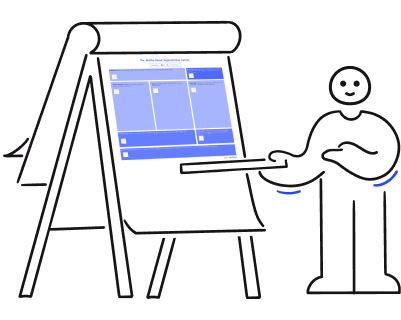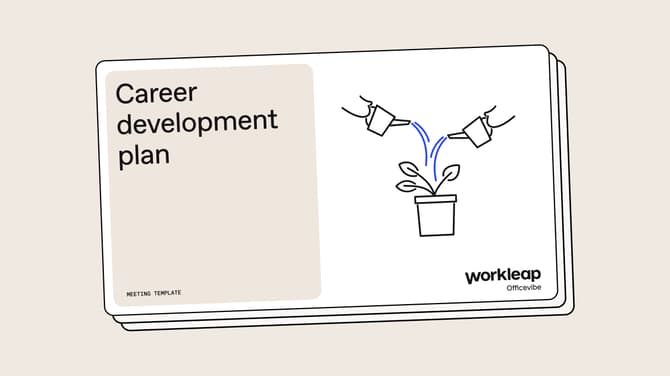Empower your organization with the skills-based canvas.

What's in this article
You were hired as an HR manager but it turns out you spend your days as a job posting copywriter. Sound familiar? Well, we’ve got good news for you. You can now focus on the important stuff and delegate the rest… to an AI sidekick.
Indeed, ChatGPT has been making waves in the tech world, with its ability to write and complete tasks with the help of AI. And we’re here to tell you it’ll rock your recruiter socks off too.
ChatGPT is a natural language processing tool (or artificial-intelligence chatbot) developed by OpenAI. With the help of prompts, it can help users by answering questions and assisting with writing tasks like composing emails, essays, and code, or editing.
With over 13 million users per day in just a few months—and a massive deal with Microsoft as it will soon be deployed across the entire Office 365 suite—ChatGPT is changing the game from search to email marketing to programming (and even writing your master's thesis).
But, more importantly, the AI-powered conversational agent on everyone's lips can help accelerate and enhance your recruitment content activities.
This article will be your playbook to crafting job postings that catch the attention of the MVPs in your industry. We'll cover everything from the fundamentals of job postings to getting the most out of ChatGPT's unique skill set. Whether you're a seasoned recruiter or a rookie HR manager, we're here to help you knock it out of the park. In fact, we actually created a tool that writes your job postings automagically (you should try it!).
Get ready to hit a homerun in the job market with the help of ChatGPT!
Anatomy of a great job posting (to help you stand out from the crowd)
Before we dive into the power of ChatGPT, let's talk about the anatomy of a great job posting.
A great job posting is clear, engaging, and informative. It should tell potential candidates exactly what they can expect from the role and what the company is looking for in a candidate. It should also be written in a way that is easy to read and understand.
To create a great job posting, you should include the following key sections:
Job Title: Make sure the job title is clear and concise to target more qualified leads. Use industry-standard terms to make it easy for prospects to find your posting—but avoid empty jargon!
If you're posting for a software developer, make sure to use terms like "full-stack developer" or "backend developer" in the job title. Avoid using vague or generic titles like "tech guru" or "coding wizard".
Company Description: Give a brief overview of your company and its culture. This will help your potential candidates determine if they would be a good fit for your company.
If you're a tech startup with a laid-back, creative culture, highlight that in your company description. For example, you could say:
We're a fast-paced startup that values creativity and innovation. Our team is made up of passionate individuals who love to push the boundaries of what's possible.
Job Description: Clearly outline the responsibilities and duties of the position. Nobody likes bulky paragraphs, so use bullet points to make it easy to read.
If you're looking for a front-end developer, clearly outline the responsibilities and duties of the position. For example:
Responsibilities include:
- Designing and implementing user interfaces
- Testing and debugging code
- Collaborating with other developers and designers
Qualifications: List the required (musts) and preferred (nice to have) qualifications for the position. Be specific and include both hard and soft skills.
For example (for a data analyst position), this could be:
Required qualifications:
- Bachelor's degree in a relevant field
- Experience with SQL and data analysis tools
Preferred qualifications:
- Experience with machine learning and data visualization
- Strong problem-solving skills
Benefits and Perks: Highlight any benefits or perks that come with the job. This can include things like health insurance, paid time off, or flexible work arrangements—things that might be attractive to your ideal candidates complementary to a competitive salary).
For example:
We offer a flexible work schedule that allows employees to work from home or choose their own hours. We also offer competitive salaries, health insurance, and a 401k matching program.
Taking your job postings to the next level with ChatGPT
Now that we’ve covered the key components of a great job posting, let's talk about how to leverage ChatGPT’s genius. The key to getting the most out of ChatGPT is to master the art of the prompt. This means understanding how to ask ChatGPT the right questions and how to guide it in the right direction.
The art of prompt
You might be asking yourself: What’s a ChatGPT prompt? A prompt is like a genie in a bottle for ChatGPT. It's the magic words you use to get it to do what you want.
A good prompt is clear, concise, and directs ChatGPT towards the information you need. It guides the AI language model to produce text that matches a particular purpose or tone. The quality of your prompt impacts the output generated by ChatGP —if your prompt is unclear, it might take a few tries before ChatGPT gets it right.
☝️Check out research tutorials, articles, and LinkedIn posts on how to prompt it properly and get better results. A cool kid to follow for that is Sam Szuchan.
Also called prompt engineering—learning how to ask chatbots the right questions, and guide them the right way, is going to be one of the most important skills we all need in the future. We'll need to learn what they're good at, what they're bad at, and how we can ask them questions that bring out the information that helps us the most.
When it comes to job postings, this means honing your prompts to make sure ChatGPT understands what you're looking for. It's important to keep in mind that ChatGPT isn't a mind-reader (yet), so you'll need to be clear and concise in your prompts.
A few pro tips to help you get started:
- Use simple, straightforward language. ChatGPT isn't a human, so it won't understand complex jargon or buzzwords. Stick to plain English and avoid unnecessary fluff.
- Be specific about what you're looking for. If you want a software developer who knows Python, for example, be sure to include those keywords in your prompt.
- Provide context for ChatGPT. If you're writing a job posting for a specific company, give ChatGPT some background information about the company and its culture, including website links. This will help it generate a posting that feels authentic to your brand tone.
With these tips in mind, you'll be well on your way to creating job postings that stand out from the crowd.
ChatGPT learns as you go
Machines—they’re just like us! Well, sorta.
ChatGPT uses machine learning algorithms that allow it to learn and improve as it interacts with you. This means the more you provide feedback on its responses, the better it will become at understanding and responding to your prompts in the future. Over time, ChatGPT will become more accurate and efficient, making it an increasingly powerful tool for generating bang-on content!
One strategy for getting the most out of ChatGPT is to role-play (the SFW kind). For example, you could pretend that ChatGPT is an HR manager and ask it questions as if you were in an interview. This will help you get better responses and more accurate job descriptions—and the conversational back-and-forth allows the AI model to pick up on what you like and don’t like out of its answers at the same time.
TL:DR ChatGPT Do’s & Don’ts
Do's:
- Use simple and easy to understand language
- Be specific about what you're looking for
- Provide context about the company and its culture (links are great!)
- Research tutorials, articles, and LinkedIn posts on how to prompt ChatGPT properly
- Role-play with ChatGPT and pretend that it is an HR manager to get better responses
- Keep your prompts clear and concise
Don'ts:
- Use complex jargon or buzzwords that ChatGPT may not understand
- Rely too heavily on ChatGPT without adding your own expertise and perspective to the job posting
- Be too vague about what you're looking for in a candidate
- Assume that ChatGPT knows everything about your company and culture without providing any background information
- Overlook the importance of A/B testing and forgetting to measure the success of your job postings
From bland to bold: injecting life into your job postings
ChatGPT is a mighty tool in your hiring arsenal, but just like a cookbook can't make a memorable dish on its own, it can't replace human creativity either. If you want to create something that stands out in a crowded marketplace, you need to put your own unique spin on it.
Injecting your company's culture and values into your job postings is one way to make them truly stand out. Just like a master chef adds secret ingredients to make their signature dish, you should add your unique blend of spices to your job posting recipe. Are you a fun-loving startup with a relaxed atmosphere? Make sure your job posting reflects that! Are you a more formal, buttoned-up company? Use language that reflects that culture.
Another way to add a secret ingredient is by using specific keywords or mantras that describe your company's unique approach to work. If your company values collaboration and teamwork, use language that emphasizes those qualities. If you're a tech company, don't forget to add some coding puns to make the posting fun and entertaining.
At the end of the day, you want your job posting to be like a handshake, a reflection of your company's personality and values — memorable, unique and confident! By infusing your job postings with your company's personality and values, you'll attract the right candidates who are a good fit for your culture. So grab your keyboard and start creating your masterpiece!
Metrics that matter: evaluating the effectiveness of your job postings
As with any marketing or advertising effort, it's important to track your results and measure your success. Here are a few metrics to keep an eye on when it comes to job postings:
- Number of applicants: This is the most obvious metric to track. Are your job postings attracting a lot of applicants, or are you struggling to find the right candidates?
- Quality of applicants: It's not just about quantity—you also want to attract high-quality candidates who are a good fit for your company. Look at factors like education, experience, and skills to evaluate the quality of your applicants.
- Time to hire: How long does it take for you to fill a position after posting it? A longer time to hire could indicate that your job postings are not effective (or that your hiring process needs improvement—but that’s for another article.)
- Cost per hire: Calculate the cost of each hire, including job board fees, recruiter fees, and other expenses. This can help you evaluate the cost-effectiveness of your job postings and identify areas where you can cut costs.
- Retention rate: Once you hire someone, how long do they stay with your company? A high retention rate indicates that you are hiring the right people and creating a positive work environment. And the cost of replacing an employee is around 9 months worth of their salary—so you want to avoid that happening as much as possible!
By tracking these metrics, you can gain insight into the effectiveness of your job postings and make adjustments as needed. Use this data to refine your job posting strategy, improve your prompts and maximize your recruitment efforts over time!
Putting your best foot forward in recruitment with ChatGPT
In today's cutthroat job market, you can't just throw a job listing into the void and hope for the best. Well—you can if you want to, but it won’t yield much results.
To stand out, you need a message that speaks directly to your dream candidate and shows off your company's unique style and values. By following the tips in this article and keeping an eagle eye on your results, you'll craft job postings with the help of ChatGPT that snap up the best and brightest talent and build a powerhouse team for your organization.
Monitor, support, and optimize your team's professional development.




